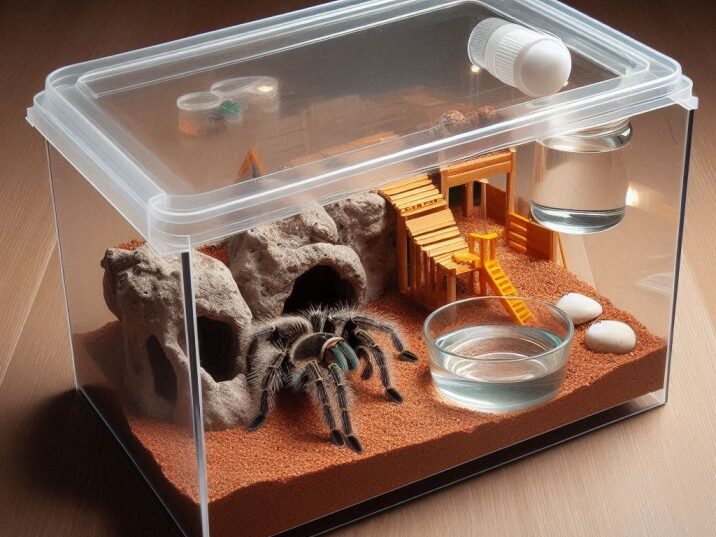Creating a comfortable and safe home for your tarantula can be a fun and rewarding experience. Whether you are a beginner or an experienced tarantula owner, building a DIY tarantula enclosure allows you to customize the habitat to meet your pet’s needs. In this guide, we’ll take you through the steps to create a cozy and secure enclosure for your tarantula, ensuring it thrives in its new home.

Choosing the Right DIY tarantula enclosure
Table of Contents
Size and Material
When selecting an enclosure, it’s crucial to choose one that suits your tarantula’s size and species. Adult tarantulas need more space than juveniles. A general rule of thumb is that the enclosure should be at least three times the leg span of your tarantula in length and twice the leg span in width.
Glass or plastic enclosures are ideal because they are easy to clean and allow you to see your pet. Glass tanks are sturdy and provide excellent visibility, but plastic containers can be a more budget-friendly option.
Ventilation
Proper ventilation is essential for maintaining a healthy environment inside the enclosure. Make sure your enclosure has enough holes or a mesh top to allow fresh air to circulate. However, the openings should not be large enough for your tarantula to escape.
Setting Up the DIY tarantula enclosure
Substrate
The substrate is the material that lines the bottom of the enclosure. It helps in maintaining humidity levels and gives your tarantula a surface to walk and dig on. Popular substrates include coconut fiber, peat moss, and vermiculite. These materials retain moisture well and are safe for your tarantula.
Example of Substrate Options Table:
| Substrate | Pros | Cons |
|---|---|---|
| Coconut Fiber | Excellent moisture retention, natural look | Can mold if too wet |
| Peat Moss | Retains humidity, natural | Can compact over time |
| Vermiculite | Great for burrowing, retains moisture | Less natural appearance |
Hiding Spots
Tarantulas need hiding spots to feel secure. You can use various items like small flower pots, cork bark, or commercially available hides. Place these hides in different parts of the enclosure to give your tarantula options.
Climbing Structures
Many tarantula species enjoy climbing. Adding pieces of cork bark, branches, or even artificial plants can provide enrichment and allow your tarantula to exhibit natural behaviors.
Maintaining the DIY tarantula enclosure
Cleaning
Regular cleaning is essential to keep your tarantula healthy. Spot clean the enclosure weekly by removing uneaten food and waste. Every few months, do a deep clean by replacing the substrate and disinfecting the enclosure with a pet-safe cleaner.
Temperature and Humidity
Maintaining the right temperature and humidity levels is crucial for your tarantula’s well-being. Most tarantulas thrive in temperatures between 70-80°F (21-27°C) and humidity levels between 60-80%. Use a thermometer and hygrometer to monitor these conditions.
Conclusion
Building a DIY tarantula enclosure is a rewarding project that ensures your pet has a safe and comfortable home. By following the guidelines on choosing the right enclosure, setting it up with appropriate substrate and decorations, and maintaining proper conditions, you can create an ideal environment for your tarantula to thrive.
FAQs
- What size enclosure do I need for my tarantula? A: The enclosure should be at least three times the leg span of your tarantula in length and twice the leg span in width.
- What is the best substrate for a tarantula enclosure? A: Coconut fiber, peat moss, and vermiculite are popular choices due to their moisture retention and safety.
- How often should I clean my tarantula’s enclosure? A: Spot clean weekly and perform a deep clean every few months.
- What temperature and humidity levels are ideal for tarantulas? A: Most tarantulas thrive in temperatures between 70-80°F (21-27°C) and humidity levels between 60-80%.
- Do tarantulas need climbing structures in their enclosure? A: Yes, many tarantula species enjoy climbing, so adding structures like cork bark or branches is beneficial.

